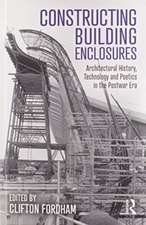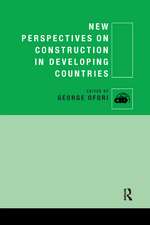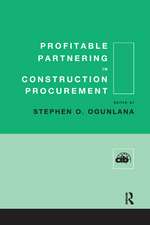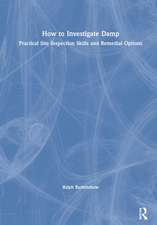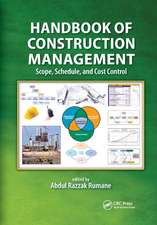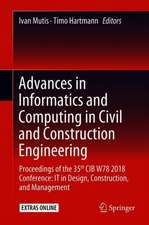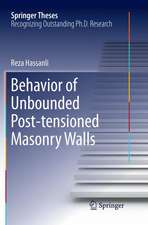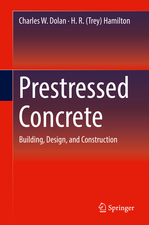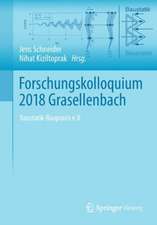Improving the Earthquake Resilience of Buildings: The worst case approach: Springer Series in Reliability Engineering
Autor Izuru Takewaki, Abbas Moustafa, Kohei Fujitaen Limba Engleză Hardback – 26 iul 2012
Improving the Earthquake Resilience of Buildings: The worst case approach consists of two parts. The first part deals with the characterization and modeling of worst or critical ground motions on inelastic structures and the related worst-case scenario in the structural design of ordinary simple building structures. The second part of the book focuses on investigating the worst-case scenario for passively controlled and base-isolated buildings. This allows for detailed consideration of a range of topics including:
A consideration of damage of building structures in the critical excitation method for improved building-earthquake resilience,
A consideration of uncertainties of structural parameters in structural control and base-isolation for improved building-earthquake resilience, and
New insights in structural design of super high-rise buildings under long-period ground motions.
Improving the Earthquake Resilience of Buildings: The worst case approach is a valuable resource for researchers and engineers interested in learning and applying the worst-case scenario approach in the seismic-resistant design for more resilient structures.
| Toate formatele și edițiile | Preț | Express |
|---|---|---|
| Paperback (1) | 946.72 lei 6-8 săpt. | |
| SPRINGER LONDON – 9 aug 2014 | 946.72 lei 6-8 săpt. | |
| Hardback (1) | 952.89 lei 6-8 săpt. | |
| SPRINGER LONDON – 26 iul 2012 | 952.89 lei 6-8 săpt. |
Din seria Springer Series in Reliability Engineering
- 18%
 Preț: 1122.56 lei
Preț: 1122.56 lei - 20%
 Preț: 1277.89 lei
Preț: 1277.89 lei - 20%
 Preț: 987.32 lei
Preț: 987.32 lei - 18%
 Preț: 1406.66 lei
Preț: 1406.66 lei - 24%
 Preț: 1048.67 lei
Preț: 1048.67 lei - 20%
 Preț: 940.32 lei
Preț: 940.32 lei - 18%
 Preț: 952.09 lei
Preț: 952.09 lei -
 Preț: 313.32 lei
Preț: 313.32 lei - 18%
 Preț: 951.29 lei
Preț: 951.29 lei - 18%
 Preț: 947.02 lei
Preț: 947.02 lei - 15%
 Preț: 651.51 lei
Preț: 651.51 lei - 18%
 Preț: 1233.83 lei
Preț: 1233.83 lei - 18%
 Preț: 1233.06 lei
Preț: 1233.06 lei - 18%
 Preț: 1234.94 lei
Preț: 1234.94 lei - 18%
 Preț: 1236.19 lei
Preț: 1236.19 lei - 18%
 Preț: 952.09 lei
Preț: 952.09 lei - 15%
 Preț: 635.65 lei
Preț: 635.65 lei - 20%
 Preț: 1274.57 lei
Preț: 1274.57 lei - 18%
 Preț: 1382.21 lei
Preț: 1382.21 lei - 15%
 Preț: 643.34 lei
Preț: 643.34 lei - 18%
 Preț: 1109.16 lei
Preț: 1109.16 lei - 15%
 Preț: 635.65 lei
Preț: 635.65 lei - 15%
 Preț: 654.62 lei
Preț: 654.62 lei - 18%
 Preț: 944.99 lei
Preț: 944.99 lei - 18%
 Preț: 953.65 lei
Preț: 953.65 lei - 18%
 Preț: 956.50 lei
Preț: 956.50 lei - 15%
 Preț: 644.95 lei
Preț: 644.95 lei - 18%
 Preț: 950.52 lei
Preț: 950.52 lei - 18%
 Preț: 1239.37 lei
Preț: 1239.37 lei - 15%
 Preț: 640.06 lei
Preț: 640.06 lei - 18%
 Preț: 956.69 lei
Preț: 956.69 lei - 18%
 Preț: 940.39 lei
Preț: 940.39 lei - 18%
 Preț: 948.92 lei
Preț: 948.92 lei -
 Preț: 389.70 lei
Preț: 389.70 lei - 18%
 Preț: 943.73 lei
Preț: 943.73 lei - 18%
 Preț: 1213.16 lei
Preț: 1213.16 lei - 18%
 Preț: 940.57 lei
Preț: 940.57 lei - 20%
 Preț: 985.03 lei
Preț: 985.03 lei - 18%
 Preț: 943.43 lei
Preț: 943.43 lei - 18%
 Preț: 1218.21 lei
Preț: 1218.21 lei - 18%
 Preț: 948.16 lei
Preț: 948.16 lei - 18%
 Preț: 948.92 lei
Preț: 948.92 lei - 18%
 Preț: 1678.16 lei
Preț: 1678.16 lei - 15%
 Preț: 638.43 lei
Preț: 638.43 lei
Preț: 952.89 lei
Preț vechi: 1162.06 lei
-18% Nou
Puncte Express: 1429
Preț estimativ în valută:
182.35€ • 188.40$ • 151.68£
182.35€ • 188.40$ • 151.68£
Carte tipărită la comandă
Livrare economică 19 martie-02 aprilie
Preluare comenzi: 021 569.72.76
Specificații
ISBN-13: 9781447141433
ISBN-10: 1447141431
Pagini: 389
Ilustrații: XVI, 324 p.
Dimensiuni: 155 x 235 x 23 mm
Greutate: 0.66 kg
Ediția:2013
Editura: SPRINGER LONDON
Colecția Springer
Seria Springer Series in Reliability Engineering
Locul publicării:London, United Kingdom
ISBN-10: 1447141431
Pagini: 389
Ilustrații: XVI, 324 p.
Dimensiuni: 155 x 235 x 23 mm
Greutate: 0.66 kg
Ediția:2013
Editura: SPRINGER LONDON
Colecția Springer
Seria Springer Series in Reliability Engineering
Locul publicării:London, United Kingdom
Public țintă
ResearchCuprins
1 Introduction.- 2. Earthquake resilience of high-rise buildings: Case study of the 2011 Tohoku (Japan) earthquake.- 3. Simulation of near-field pulse-like ground motion.- 4. Critical characterization and modeling of pulse-like near-field strong ground motion.- 5. Characteristics of earthquake ground motion of repeated sequences.- 6. Modeling critical ground-motion sequences for inelastic structures.- 7. Response of Nonlinear SDOF Structures to Random Acceleration Sequences.- 8. Use of deterministic and probabilistic measures to identify unfavorable earthquake records.- 9. Damage Assessment to Inelastic Structure Under Worst Earthquake Loads.- 10 Critical earthquake loads for SDOF inelastic structures considering evolution of seismic waves.- 11. Critical Correlation of Bi-Directional Horizontal Ground Motions.- 12. Optimal placement of viscoelastic dampers and supporting members under variable critical excitations.- 13 Earthquake response bound analysis of uncertain passively controlled buildings for robustness evaluation.- 14 Earthquake response bound analysis of uncertain base-isolated buildings for robustness evaluation.- 15. Future Directions.
Notă biografică
Dr. Izuru Takewaki is a Professor in the Department of Architecture and Architectural Engineering, College of Engineering, Kyoto University, Japan. Dr. Takewaki authored more than 100 international journal papers and authored 4 monographs in English on Structural Optimization, Critical Excitation Methods and Structural Health Monitoring. He serves as an editorial board member in several international journals (e.g. Engineering Structures, Soil Dynamics and Earthquake Engineering, Structural Control and Health Monitoring). He is one of the Editors-in-Chief of Int J of Earthquakes and Structures.
Dr. Abbas Moustafa is an Associate Professor at the Department of Civil Engineering, Minia University, Egypt and the Chairman of the Department of Civil Engineering, High Institute of Engineering, Giza, Egypt. He is also a consultant engineer and head of structural group, Hamza Associates, Giza, Egypt. He has about 30 international journal papers and is the editor of two books on earthquake-resistant structures and geotechnical earthquake engineering. Dr. Moustafa was a JSPS fellow at Kyoto and Nagasaki Universities and was also a research associate at Vanderbilt University.
Dr. Kohei Fujita is a post doctoral fellow in Kyoto University, Japan. Dr. Fujita received a PhD from Kyoto University in 2012. He authored more than 10 international journal papers.
Dr. Abbas Moustafa is an Associate Professor at the Department of Civil Engineering, Minia University, Egypt and the Chairman of the Department of Civil Engineering, High Institute of Engineering, Giza, Egypt. He is also a consultant engineer and head of structural group, Hamza Associates, Giza, Egypt. He has about 30 international journal papers and is the editor of two books on earthquake-resistant structures and geotechnical earthquake engineering. Dr. Moustafa was a JSPS fellow at Kyoto and Nagasaki Universities and was also a research associate at Vanderbilt University.
Dr. Kohei Fujita is a post doctoral fellow in Kyoto University, Japan. Dr. Fujita received a PhD from Kyoto University in 2012. He authored more than 10 international journal papers.
Textul de pe ultima copertă
Engineers are always interested in the worst-case scenario. One of the most important and challenging missions of structural engineers may be to narrow the range of unexpected incidents in building structural design. Redundancy, robustness and resilience play an important role in such circumstances. Improving the Earthquake Resilience of Buildings: The worst case approach discusses the importance of worst-scenario approach for improved earthquake resilience of buildings and nuclear reactor facilities.
Improving the Earthquake Resilience of Buildings: The worst case approach consists of two parts. The first part deals with the characterization and modeling of worst or critical ground motions on inelastic structures and the related worst-case scenario in the structural design of ordinary simple building structures. The second part of the book focuses on investigating the worst-case scenario for passively controlled and base-isolated buildings. This allows for detailed consideration of a range of topics including:
•A consideration of damage of building structures in the critical excitation method for improved building-earthquake resilience,
•A consideration of uncertainties of structural parameters in structural control and base-isolation for improved building-earthquake resilience, and
•New insights in structural design of super high-rise buildings under long-period ground motions.
Improving the Earthquake Resilience of Buildings: The worst case approach is a valuable resource for researchers and engineers interested in learning and applying the worst-case scenario approach in the seismic-resistant design for more resilient structures.
Improving the Earthquake Resilience of Buildings: The worst case approach consists of two parts. The first part deals with the characterization and modeling of worst or critical ground motions on inelastic structures and the related worst-case scenario in the structural design of ordinary simple building structures. The second part of the book focuses on investigating the worst-case scenario for passively controlled and base-isolated buildings. This allows for detailed consideration of a range of topics including:
•A consideration of damage of building structures in the critical excitation method for improved building-earthquake resilience,
•A consideration of uncertainties of structural parameters in structural control and base-isolation for improved building-earthquake resilience, and
•New insights in structural design of super high-rise buildings under long-period ground motions.
Improving the Earthquake Resilience of Buildings: The worst case approach is a valuable resource for researchers and engineers interested in learning and applying the worst-case scenario approach in the seismic-resistant design for more resilient structures.
Caracteristici
Considers the elastic-plastic behavior of building structures in the critical excitation method for improved building-earthquake resilience Approaches the uncertainties of structural parameters in structural control and base-isolation for improved building-earthquake resilience Provides new insights in structural design of super high-rise buildings under long-period ground motions (case study on tall buildings in mega cities in Japan during the 2011 off the Pacific coast of Tohoku earthquake on March 11) Instructs readers on how to implement the worst-scenario approach to provide engineers with effective design techniques Includes supplementary material: sn.pub/extras


